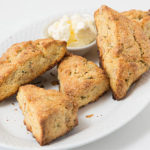
All the wheat we have today is descended from einkorn, which has been growing wild in the Middle East for millions of years, way before humans came along. Wild emmer wheat is einkorn’s firstborn, the product of a natural hybridization between einkorn and another wild grass. These are the two wild wheats that Paleolithic hunter-gatherers in the Fertile Crescent would have encountered. And about 10,000 years later, the same two varieties (along with barley) were the ones that Neolithic humans started cultivating—the wheat and the humans each domesticating the other.
Einkorn is both familiar and not. Unlike more common wheat varieties, it has an inedible hull surrounding the kernel that has to be removed. (That’s where the saying “separating the wheat from the chaff” comes from.) It is finicky to grow and relatively low yielding, which is why it was almost abandoned, except in small pockets of Turkey and Europe. When ground, it has a yellow, carroty cast from lots of beta-carotene, and its gluten is different from that in today’s wheat. . .
Visit Saveur‘s web site to read the full article, Down with Boring White Bread.
Excerpted with permission from Saveur magazine, Oct./Nov 2016, Issue#185. Recipe by Saveur editors, adapted from Brooklyn Bread Lab. Photo by Matt Taylor-Gross.
 Editor-in-Chief Adam Sachs and Test Kitchen Director Stacy Adimando talked with Faith about this recipe in a special fundraising edition of The Food Schmooze®. With a contribution of $5 a month, you can subscribe to Saveur and support The Faith Middleton Food Schmooze® at the same time. We hope you will. Thank you!
Editor-in-Chief Adam Sachs and Test Kitchen Director Stacy Adimando talked with Faith about this recipe in a special fundraising edition of The Food Schmooze®. With a contribution of $5 a month, you can subscribe to Saveur and support The Faith Middleton Food Schmooze® at the same time. We hope you will. Thank you!

| Servings |
| 8 scones |
|
|

|
Einkorn flour has a subtle sweetness that pairs incredibly well with honey and nuts. More substantial than white flour but less dense than regular whole wheat flour, it makes perfectly textured, toothsome scones, like these.
|
- 1 cup hazelnuts
- 4 ounces (one stick) cold unsalted butter
- 3 cups all-purpose einkorn flour plus more for dusting
- 1/4 cup granulated sugar
- 3/4 teaspoon kosher salt
- 1-1/2 teaspoons baking powder
- 1 tablespoon plus 2 teaspoons coarsely chopped fresh rosemary
- 1/2 cup buttermilk
- 1/2 cup heavy cream plus more for brushing
- 2-1/2 ounces honeycomb (about 2-1/2 tablespoons)
- coarse sugar such as turbinado or Demerara, for topping
- Preheat the oven to 350°. Add the hazelnuts to a baking sheet and bake until the skins are darkened and some are easy to loosen, 10 to 12 minutes. Remove and set aside to cool slightly. Remove and discard as much of the skin as possible by rubbing with fingers, then coarsely chop the nuts.
- Meanwhile, grate the cold butter on the large side of a box grater; chill.
- In a large bowl, whisk the flour, granulated sugar, salt, and baking powder to combine. Add the butter, mixing briefly with fingers to distribute. Add the chopped hazelnuts and rosemary, tossing to coat.
- In a medium bowl, combine the buttermilk and heavy cream, then slowly add the mixture to the dry ingredients, stirring with a spatula to incorporate. Break up the honeycomb into small pieces with your fingers and mix into the dough by hand to distribute throughout.
- On a parchment-lined baking sheet that's been lightly dusted with more einkorn flour, turn out the dough. Using floured hands, shape into a 12-inch-long, 1-inch-thick rectangle. Chill until firm, about 1 hour.
- Preheat the oven to 400°. Using a sharp knife, make a diagonal cut crosswise through the dough every 3 inches to form 8 triangular scones. Separate the scones across the baking sheet, leaving at least 2 inches between each. Brush the scones with heavy cream and sprinkle each with about 1⁄4 tsp. coarse sugar.
- Bake until lightly browned on the top and golden-brown on the bottom, 18 to 24 minutes. Remove and let cool 5 minutes, then transfer to a rack to cool completely.

